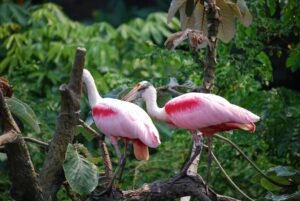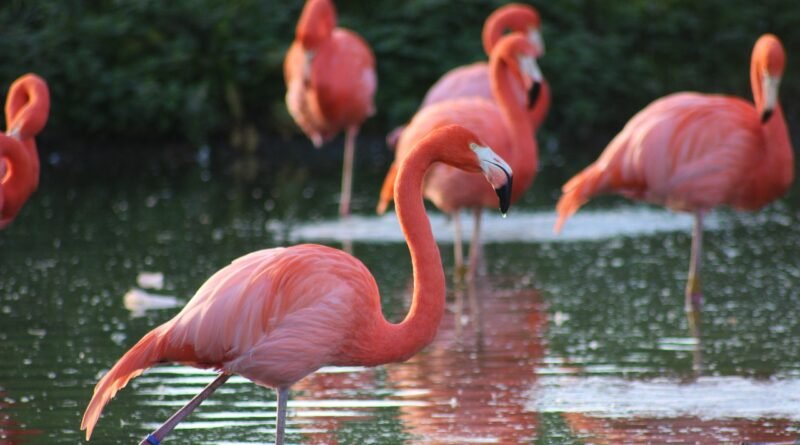Discovering Pink Birds
Pink birds are celebrated for their soft, delicate plumage that adds a splash of color to diverse ecosystems around the world. From flamingos wading in tropical lagoons to rosy finches perched in alpine meadows, these avian wonders captivate with their beauty and intriguing adaptations. In this article, we embark on a journey to explore the enchanting world of pink birds, delving into their diversity, habitats, behaviors, and conservation significance.
I. Introduction to Pink Birds
A. Definition and Perception
Pink birds exhibit varying shades of pink or rosy hues in their feathers, often derived from pigments in their diet or specialized structural coloration. The color pink is associated with elegance, femininity, and vibrancy in the natural world.
B. Significance of Plumage Coloration
The pink plumage of birds serves multiple purposes, including species recognition, mate attraction, and thermoregulation. Pink birds often display striking colors during courtship displays, showcasing their vitality and genetic fitness.
II. Notable Species of Pink Birds
A. Greater Flamingo (Phoenicopterus roseus)
The greater flamingo is one of the most iconic pink birds, known for its long, slender neck and vibrant pink feathers. These birds inhabit saline lakes and estuarine habitats, where they filter-feed on algae and crustaceans.
B. Roseate Spoonbill (Platalea ajaja)
The roseate spoonbill is a striking wading bird with a pink plumage and distinctive spoon-shaped bill. Found in wetlands of the Americas, these birds use their bills to sweep through shallow water, capturing small fish and invertebrates.
C. Rosy-faced Lovebird (Agapornis roseicollis)
Native to arid regions of southwestern Africa, the rosy-faced lovebird displays pinkish plumage on its face and chest. These sociable parrots form strong pair bonds and are often kept as pets due to their charming personalities.
D. Pink-headed Duck (Rhodonessa caryophyllacea) – Extinct
The pink-headed duck, once found in South Asia, is now considered extinct. It was known for its distinctive pink head and sought-after by collectors, contributing to its decline.
E. Pink Robin (Petroica rodinogaster)
The pink robin, native to Australia, is a small passerine bird with a pale pink breast and belly. It inhabits dense forests and is known for its melodious song and agile foraging behavior.
III. Habitat and Distribution
A. Wetland and Coastal Environments
Many pink birds are associated with wetland habitats, such as lakes, marshes, and coastal estuaries. These areas provide abundant food resources and safe nesting sites for waterfowl and wading birds.
B. Tropical and Subtropical Regions
Pink birds are often found in tropical and subtropical regions, where diverse ecosystems support a rich variety of avian species adapted to warm climates.
C. Human-Altered Landscapes
Some pink bird species, like the roseate spoonbill, have adapted to human-altered landscapes, utilizing man-made reservoirs and rice paddies as foraging grounds.
IV. Behaviors and Adaptations

A. Feeding Ecology
Pink birds exhibit diverse feeding strategies, including filter-feeding, probing mudflats, and sipping nectar from flowers. Their specialized bills and foraging techniques are adapted to exploit specific food sources in their habitats.
B. Breeding and Parental Care
During the breeding season, pink birds engage in elaborate courtship rituals and nest-building behaviors. Many species form monogamous pairs and share parental duties, ensuring the survival of their offspring.
C. Vocalizations and Communication
Pink birds use vocalizations, displays, and body postures to communicate with mates and establish territories. Their calls vary in pitch and intensity, conveying information about food availability and potential threats.
V. Conservation Status and Threats
A. Habitat Loss and Degradation
Pink birds are vulnerable to habitat loss due to urbanization, agriculture, and climate change. Wetland destruction and water pollution pose significant threats to species that depend on pristine ecosystems.
B. Hunting and Trade
Some pink bird species, like parrots and waterfowl, are targeted by hunters for their plumage or as exotic pets. Unsustainable harvesting and illegal wildlife trade contribute to population declines.
C. Conservation Efforts
Conservation initiatives aimed at protecting pink birds include habitat restoration, establishment of protected areas, and captive breeding programs. Public awareness campaigns raise awareness about the importance of preserving critical habitats.
VI. Human Interaction and Cultural Significance

A. Ecotourism and Birdwatching
Pink birds attract birdwatchers and nature enthusiasts, contributing to ecotourism and local economies. Birding tours promote conservation and support efforts to conserve avian habitats.
B. Symbolism and Mythology
In various cultures, pink birds symbolize love, grace, and spirituality. They appear in folklore, art, and literature as symbols of beauty and resilience, reflecting humanity’s deep connection with the natural world.
VII. Conclusion: Celebrating Pink Birds
Pink birds enchant us with their elegant plumage, fascinating behaviors, and ecological importance. By understanding and conserving these avian treasures, we contribute to the preservation of Earth’s biodiversity and ensure a sustainable future for generations to come.

